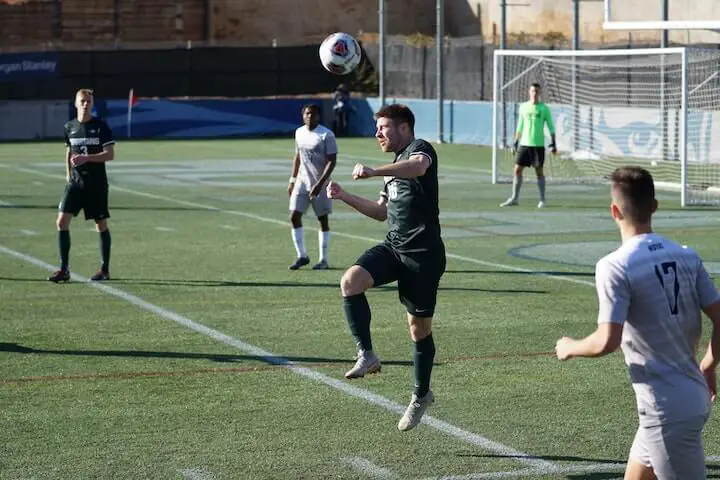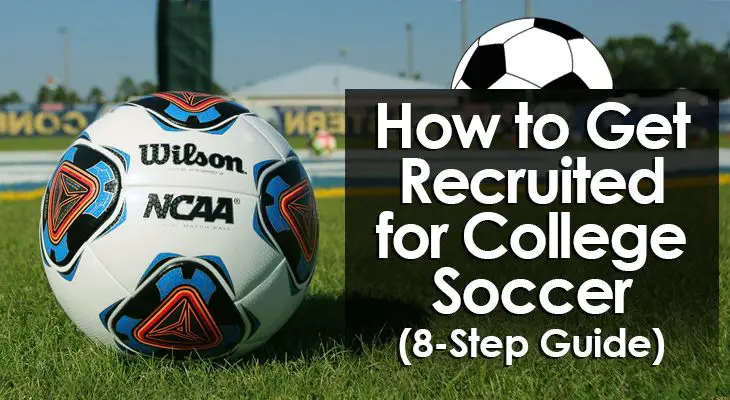How to Get Recruited for College Soccer (8-Step Guide)
The number of participants (male and female) in high school soccer has steadily increased over the past two decades.
Close to 1 million players represent their schools in the U.S. each year.
However, student-athlete recruitment is highly competitive, with only 7% of high school hopefuls making it to varsity level in college.
Despite the competitive landscape, high school players shouldn’t be deterred...
There is a well-trodden path to getting recruited, and you can take certain steps now to give yourself the best chances of getting into your dream school.
Here’s our 8-step guide on how to get recruited for college soccer.
Step #1: Make a List of Potential Colleges
Setting clear, tangible goals is critical to achieving anything in life.
This is especially true when it comes to the ultra-competitive world of college athletics.
Having something specific to strive for can make all the difference on days when you lack motivation or are mulling over whether or not to skip a gym session.
Making a list of schools that align with your ambitions, academic profile, and financial situation will make the recruitment process far less overwhelming for you.
It’s important to do this as soon as possible, as you’ll need to make contact with recruiters and scouts to ensure you’re on their radar.
If you have serious ambitions about playing high-level college soccer, my recommendation is to set your sights on targets by your sophomore year.
D1 scouts start evaluating talents in the 10th grade and may even reach out to prospects before they begin their sophomore year.
How to Make a College List
First of all, don’t set self-limitations.
If you don’t believe you can start for a D1 college team, it’s unlikely that anyone else will.
Set lofty goals and consider adding some D1 schools to challenge yourself.
That said, it’s always important to have a plan B.
Set aside a safety net of schools that you think you have a good chance of getting into.
After all, if you put in the work to get into a top school but ultimately fall short, you’ll be a hell of a better player by the time college offers come in.
While there’s no magic number for college applications, consider compiling a list of 20 to 40 schools.
Bear in mind that some colleges charge application fees and the paperwork can be time-consuming.

Step #2: Establish the Requirements
After setting your goals, now it’s time to form a plan to make them a reality.
When applying to a college soccer program, you’re judged on your performance both on the field AND in the classroom.
In terms of academics, colleges (including D3 schools) typically have different requirements, including a minimum GPA average.
You can find specific information on the college website or through a recruiter.
However, if you want to get into an NCAA D1 or D2 school, eligibility is dependent on three important criteria:
1. Core Course Requirements
All NCAA prospects must pass a minimum of 16 core courses throughout their high school.
These are a combination of English, math, natural or physical science, social science, a foreign language, and religion or philosophy.
Your high school should have a list of NCAA-approved classes so make sure you’re enrolled.
2. Core Course GPA
The NCAA only considers core courses when analyzing your GPA.
This affords you some flexibility if you’re taking additional classes.
D1 programs look for a minimum of a 2.3 GPA, while D2 schools may accept a 2.0.
3. SAT/ACT Grades
NCAA recruitment depends on a combination of your SAT/ACT score and your core course GPA.
This requirement is what's called the NCAA sliding scale. Essentially, a higher score on your SAT./ACT can offset a lower core course GPA.
If you want to learn more about the sliding scale, check out the NCSA website.
Step #3: Put Together a Training Program
Players looking to get recruited must go the extra mile to be able to perform at their best.
This means looking after your diet, focusing on recovery, and extra sessions off the field.
Whether you need to improve your stamina levels to compete over 90 minutes, add some bulk, or work on skill-based weaknesses, put together an extra-curricular training schedule.
For a more detailed plan on skill development, check out this article.
Another great approach is to build a program with a reliable coach or hire a personal trainer to help you set and reach your goals.
While there’s always room to improve, young players must be careful not to overtrain.
Pushing the body beyond its means is counterproductive, often leading to diminished performances and injury. It can also drain you of motivation.
If your high school training schedule keeps you in top shape, don’t worry about running miles at 6 am or sticking to an intense strength and conditioning program.
There are always other ways to improve your recruitment chances, such as:
> Researching college teams and their styles of play.
> Studying modern tactics and positioning.
> Analyzing professional players, their habits, and routines.
> Prioritizing rest and recovery (massages, ice baths, stretching).
> Watching footage on upcoming opponents.
Recording your training sessions and games helps you break down your performance, identify weaknesses, and come up with ways to improve.
This also provides you with footage to create a highlight video, which leads us to our next tip.
Further Reading: 6 Soccer Workouts to Improve Your Game (Skills, Cardio, Gym)
Step #4: Create Promotional Content
Video content is now a standard part of the soccer recruitment process.
Although most coaches prefer to watch players in person, it’s not feasible to attend hundreds of games every year, never mind thousands.
A highlight reel video increases your chances of getting noticed and may even encourage coaches to reach out or attend a game.
In most cases, recording games is your responsibility since most high schools don’t have in-house camera crews to follow their team around.
Get your hands on a tripod and find the best angles to capture footage.
(Make sure someone trustworthy keeps an eye on it!)
Recording practice sessions are useful for self-assessment but typically shouldn’t make the final cut of your highlight reel.
Use games or footage from ID camps (more on these later) as the primary focus of your recruitment video.
Depending on your position, you may have more or fewer key moments to share.
Here are some tips for your video:
> Keep it to around 5 minutes or under (25 snippets should do the trick).
> Don’t worry about an introduction or non-playing footage.
> Omit fancy edits or music as coaches focus on the footage only.
> Include important information on clips from tournament finals or an ID camp (optional).
> Put your best clips at the beginning of the video to make sure they’re seen.
Step #5: Make Contact with Colleges
There is a right way and a wrong way to contact your prospective college coach.
Let’s begin with things you should avoid.
Don’t show up to a coach’s office or practice session unannounced, and refrain from contacting them without notice.
This comes off as unprofessional and may raise red flags about your off-the-field manner.
Fortunately, there are several ways to reach out to school athletic departments -- you may even find a direct line to the coaching staff.
Most NCAA schools also have online questionnaires available to high schoolers.
This allows them to leave contact information and enter their communications database.
To contact a school, here’s what you should do:
> Fill out the online recruitment questionnaire for your target programs.
> Send a friendly and professional email to the coaching department, noting your achievements, statistics, and ambitions. Provide a link to your highlight reel or promotional video.
> Wait a few days before making a follow-up call to each coach, using the number provided on the college website. Mention your email and video.
> Respond to all emails promptly, providing any requested information.
> Once communication lines are open, continue to give updates on results, stats, and video highlights.
> Share your game schedule for the scouting department.
It’s important to note that all communication should come from you - the student-athlete - and not your parents.

Step #6: Attend Showcases and Tournaments
Unfortunately, coaches and recruiters don’t have the bandwidth to review every student’s highlight video and attend their games.
To make the most efficient use of their time, coaches use "soccer ID camps" to spectate the best talents in the country.
These events take place year-round, but summer ID camps are most common as they don’t clash with the NCAA regular season.
Since the NCAA recruiting schedule is summer-focused, the off-season is your best opportunity to perform in front of top coaches and recruiters.
If you have ambitions of making it to one of the top soccer programs in the U.S., identify as many ID camps as possible and get signed up!
This doesn’t mean flying from state to state all summer, racking up air miles on your parents’ dime... Target local college camps or third-party events on neutral grounds near your city.
That said, if you are invited to a camp, this indicates that you’re already on the coach’s radar so do your best to attend.
What to Expect at These Events:
It can be intimidating to show up to a high-level showcase, especially if you don’t know anyone.
Just remember to soak in the occasion, try your best, and enjoy yourself.
You’ll have plenty more opportunities if one camp doesn’t go your way.
Some events are single-day affairs but the top camps typically last 3 to 4 days.
They can cost anywhere from $100 to $500 per player.
If it's hosted by a college, you may have the opportunity to stay on campus or in nearby dorms with fellow athletes.
As for the itinerary, here’s what you can expect:
> Skill, athleticism, and fitness-focused drills, coordinated by elite coaches.
> Face-to-face communication with college coaches and recruiters.
> Coaching seminars and tactical discussions.
> Q&A opportunities.
> Competitive scrimmages with other campers.
How to Stand Out at an ID Camp:
It’s important to show up to camp prepared and in shape to give yourself the best opportunity.
Reopen communication lines with coaches two weeks ahead of the event to let them know you’ll be attending. That way, you’ll stand out from the get-go.
Don’t be shy to introduce yourself when given the opportunity, ensuring spectating coaches recognize you among the crowd.
When you get down to business, be attentive, coachable, and competitive.
Remember that soccer is a team game, so selfishness and hunting for personal glory will make you stand out for all the wrong reasons.
Try to build rapport with other attendees and demonstrate that you’re a team player and a valuable addition to a group environment.
Viewing other players as your enemies is one of the biggest mistakes you can make.
Don’t Take Risks With Injuries:
One important thing to note...
If you’re carrying an injury, stay home.
Coaches may not be aware of your health and your performance may not reflect your true ability.
What’s more, you could further aggravate the injury, jeopardizing your long-term potential.
If you've already registered, contact the event organizers and let them know you won’t be there due to injury.
Injuries are part of the game and coaches know this.
Top Camps to Keep an Eye Out For
All ID camps should be an opportunity to showcase your talents.
Some notable events are known to attract top players, coaches, and recruiters, such as:
Step #7: Don’t Let Your Grades Slide
Players:
PLEASE don’t let your grades be the reason you miss out on a place on a college soccer team.
As we discussed, all schools lay out their requirements clearly.
Stay on top of your academics and seek help if you’re struggling to keep up.
Far too many talents limit their potential by slacking in the classroom.
With only 2% of college NCAA soccer players making it to the big leagues after graduation, education is likely to be your contingency plan if professional soccer doesn’t work out.
Step #8: Handling Recruitment Proposals
The media glorifies national signing day, drawing attention to the biggest prospects officially pledging to the major colleges.
But there are actually two signing days.
For soccer, the first takes place in November, while the second and final day occurs in August.
NCAA schools send out a National Letter of Intent (NLI) to each recruit with details of their scholarship and offer.
However, many student-athletes receive acceptance letters outside of these dates.
If you get an acceptance letter of any kind, it’s important to know that it is a legally binding document. Triple-check all disclosed information before signing an agreement.
You should also know that scholarships are negotiable, so you can counter offer to get a better deal.
In general, the best negotiation tool is letters of intent from other colleges.
While it’s not worth endangering your scholarship, explore whether there is room to arbitrate.
Once you and your family are happy with the proposal, sign on the dotted line and realize your dream of becoming a recruited college soccer player.

Conclusion
So there you have it:
A step-by-step guide for how to get recruited for college soccer.
Remember, it’s normal to feel pressure when making moves that affect your future.
However, learning to enjoy the process helps with performance, mood, and quality of life.
If you don’t get recruited, don’t worry.
Junior colleges and club soccer offer backdoors into better programs.
Best of luck!
Further Reading: How to Become a Professional Soccer Player (10-Step Guide)

